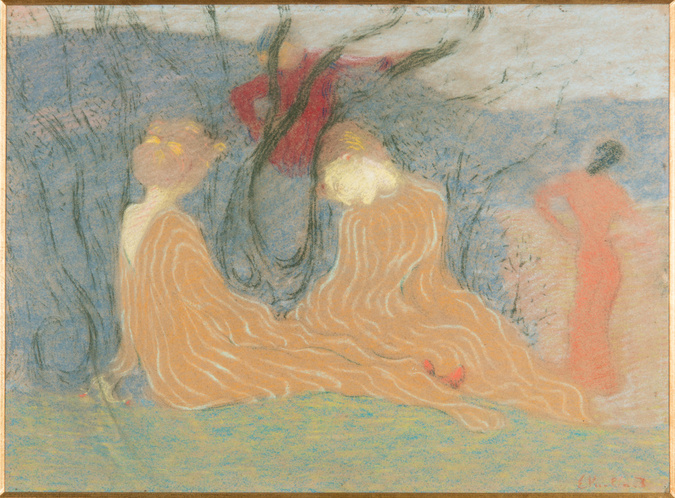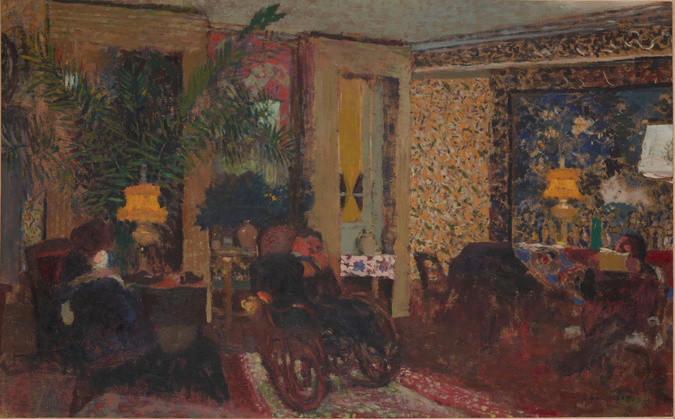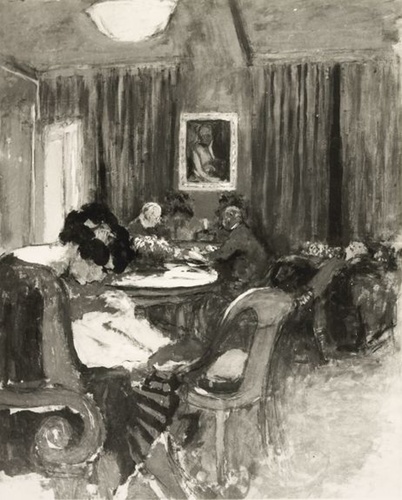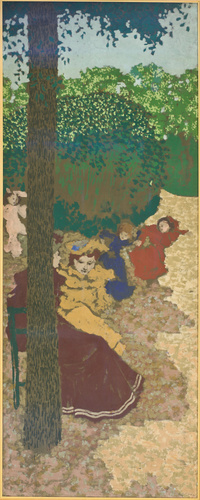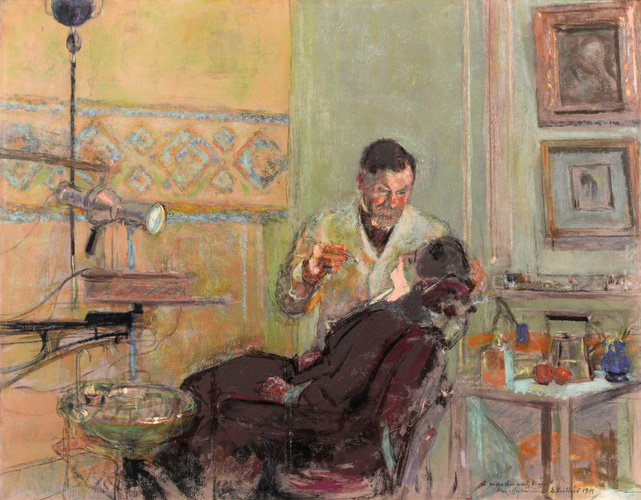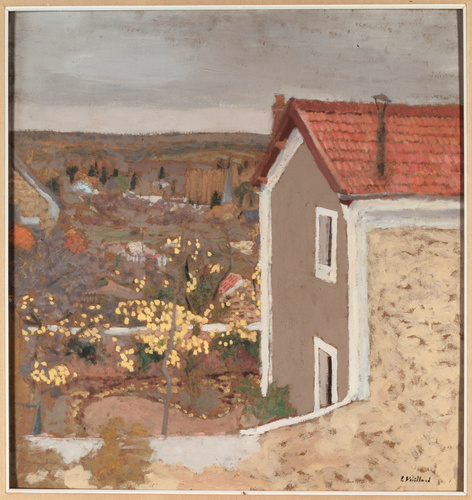Le Déjeuner
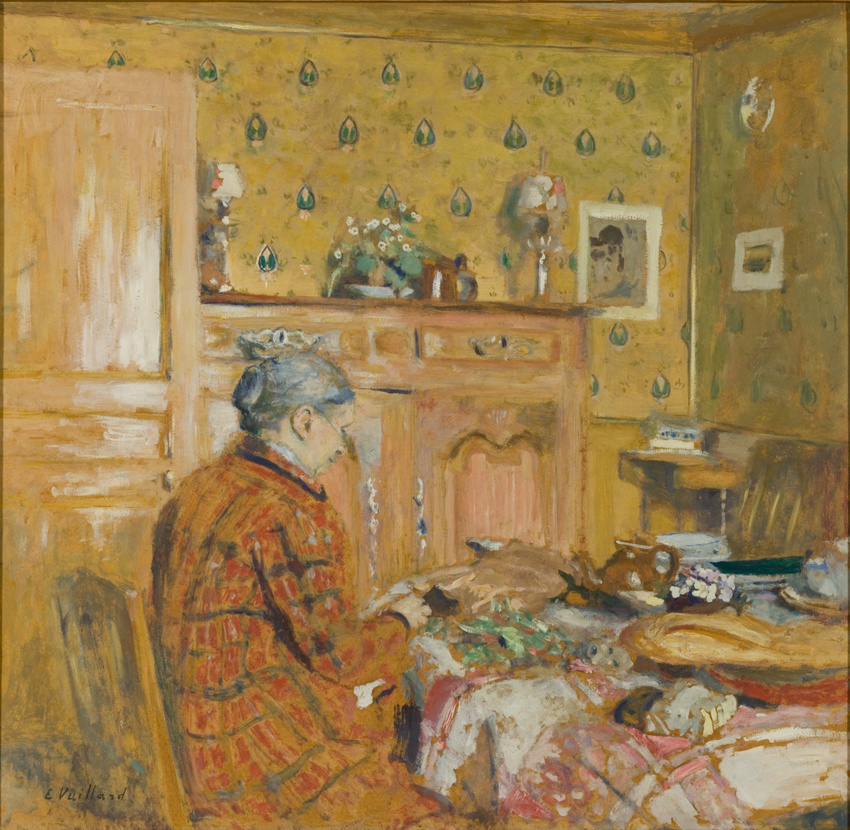
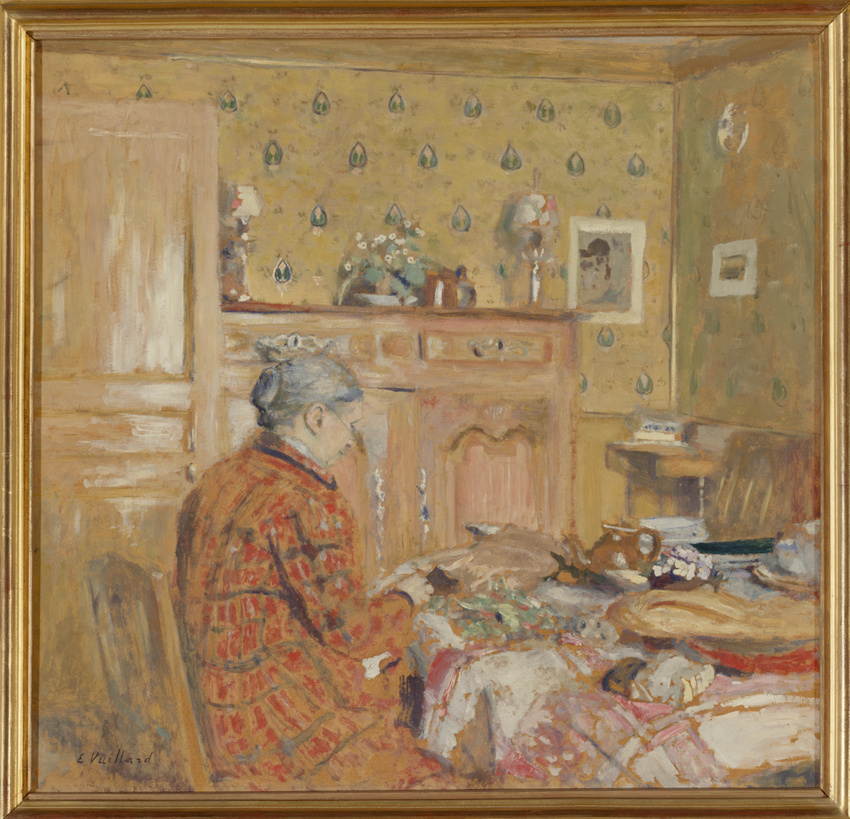
From the beginning, Vuillard's art took an intimist and autobiographical direction that marked all of his work. This breakfast scene, painted around 1900, shows the artist's mother seated at the table in the half-light, in a comfortable bourgeois setting. At this time, the artist was moving away from the Nabi stylisation, and going back to using light to create perspective and modelling effects.
Vuillard never tired of observing his mother as she went about her daily tasks. He painted her while she was sewing, reading and attending to her household chores. A former corset maker, she had raised her son in the cosy atmosphere of her workshop, filled with ribbons and fabrics. This is probably where his love of wallpapers, tablecloths and clothes, found in many of his paintings, originated. His interest was strengthened by the decorative motifs of certain Japanese prints, themselves inspired by the designs on kimonos.
The Artist's Mother taking Breakfast is not without any Japanese influence, noticeable in the asymmetry of the composition and in the subject itself of the painting. Harunobu (around 1725-1770), in particular, painted many interior scenes featuring women occupied with calm, domestic tasks.
As an intimist and decorative artist above all else, Vuillard expresses the everyday poetry of this closed world – a rather stifling world, filled with objects and fabrics – with a familiar technique of his where he plays on the tiniest nuances of colour. In delicate harmonies, which blend into each other like a tapestry, Vuillard merely suggests shapes in order to convey better the gentle intimacy of this décor, as well as the solitude and the inability to communicate between even the closest human beings.
- acquis de l'artiste par Bernheim-Jeune, le 9 décembre 1903 pour 800 fr. (n° de stock 13462)
- acquis par l'Etat pour le musée du Luxembourg chez Bernheim-Jeune, le 24 décembre 1903 pour 800 fr
- 1903-1947, musée du Luxembourg
- Jusqu'en 1977, musée national d'art moderne
- 1977, affecté au musée du Louvre pour les collections du musée d'Orsay (arrêté du 26/09/1977
- 1977, musée d'Orsay, Paris
- 2017, déposé au musée des Beaux-Arts, Nantes (arrêté de dépôt du 03/05/2017)
- Salon d'automne - Petit Palais - Musée des Beaux-Arts de la Ville de Paris - France, Paris, 1903, N°568
- Exposition E. Vuillard - musée des Arts décoratifs - France, Paris, 1938, n° 84
- Exposition de peinture contemporaine. Maurice Denis. Ses maîtres. Ses amis. Ses élèves. - musée de Cambrai - France, Cambrai, 1945-1946
- Exposition de peinture contemporaine. Maurice Denis. Ses maîtres. Ses amis. Ses élèves. - organisme inconnu - France, Orléans, 1945-1946
- Exposition de peinture contemporaine. Maurice Denis. Ses maîtres. Ses amis. Ses élèves. - ville - France, Dijon, 1945-1946
- Exposition de peinture contemporaine. Maurice Denis. Ses maîtres. Ses amis. Ses élèves. - ville - France, Nice, 1945-1946
- Exposition de peinture contemporaine. Maurice Denis. Ses maîtres. Ses amis. Ses élèves. - ville - France, Montpellier, 1945-1946
- Exposition de peinture contemporaine. Maurice Denis. Ses maîtres. Ses amis. Ses élèves. - musée d'Art et Archéologie - Espagne, Valence, 1945-1946
- Exposition de peinture contemporaine. Maurice Denis. Ses maîtres. Ses amis. Ses élèves. - organisme inconnu - France, Annecy, 1945-1946
- Exposition de l'Unesco - musée national d'art moderne - France, Paris, 1946, sans n°
- Exhibition of paintings by Pierre Bonnard and Edouard Vuillard - Royal Scottish Academy - Royaume-Uni, Édimbourg, 1948, n° 77
- Les peintures de Denis, Vuillard, Bonnard du musée national d'Art moderne de Paris - musée des Beaux-Arts - Belgique, Liège, 1948, n° 23
- Les peintures de Denis, Vuillard, Bonnard du musée national d'Art moderne de Paris - musée des Beaux-Arts - Belgique, Gand, 1948, n° 23
- Les peintures de Denis, Vuillard, Bonnard du musée national d'Art moderne de Paris - musée national d'Histoire et d'Art - Luxembourg, Luxembourg, 1948-1949, n° 23
- Vuillard. Hommage à Madame Vuillard - galerie Hector Brame - France, Paris, 1953
- La femme dans l'art français - palais des Beaux-Arts - Belgique, Bruxelles, 1953
- Salon d'Automne. Exposition de son cinquantenaire - Galeries nationales du Grand Palais - France, Paris, 1953, sans n°
- 120 Meisterwerke du Musée d'Art Moderne - organisme inconnu - Allemagne, Francfort-sur-le-Main, 1956-1957, sans n°
- 120 Meisterwerke du Musée d'Art Moderne - organisme inconnu - Luxembourg, Luxembourg, 1956-1957, sans n°
- 120 Meisterwerke du Musée d'Art Moderne - Akademie der Künste - Allemagne, Berlin, 1956, sans n°
- Paintings from the Musée d'Art Moderne - National Museum Cqrdiff - Royaume-Uni, Cardiff, 1957, n° 81
- Paintings from the Musée d'Art Moderne de Paris - Royal British Academy Galleries - Royaume-Uni, Londres, 1957, n° 81
- Pierre Bonnard. Oeuvre de jeunesse, maturité et vieillesse - Kröller-Müller Museum - Pays-Bas, Otterlo, 1960-1961, sans n°
- Cien Anos de pintura en francia de 1850 a nuestros dias - Museo Nacional de Arte Moderno - Palacio de Bellas Artes - Mexique, Mexico, 1962
- Cien Anos de pintura en francia de 1850 a nuestros dias - Museo de Bellas Artes - Venezuela, Caracas, 1962
- Hommage à Roger Marx 1859-1913 : De Daumier à Rouault - musée des Beaux-Arts - France, Nancy, 1963
- 20e festival de la Rhur - Kunsthalle - Allemagne, Recklinghausen, 1966, n° 213
- Painting in France 1900-1967 - National Gallery of Art - Etats-Unis, Washington, 1968, n° 44
- Painting in France 1900-1967 - Metropolitan Museum of Art - Etats-Unis, New York, 1968, n° 44
- Painting in France 1900-1967 - Museum of Fine Arts - Etats-Unis, Boston, 1968, n° 44
- Painting in France 1900-1967 - The Art Institute of Chicago - Etats-Unis, Chicago, 1968, n° 44
- Painting in France 1900-1967 - M. H. De Young Memorial Museum - Etats-Unis, San Francisco, 1968, n° 44
- Le Parisien chez lui au XIXe siècle 1814-1914 - archives nationales - France, Paris, 1976-1977
- Vuillard - musée des Beaux-Arts - France, Lyon, 1990
- Vuillard - musée des Beaux-Arts - France, Nantes, 1991
- Paris in the late 19th century - National Gallery of Australia - Australie, Canberra, 1996-1997, p.96
- Paris in the late 19th century - Queensland Art Gallery - Australie, Brisbane, 1997, p.96
- Edouard Vuillard. La porte entrebâillée - musée de l'Annonciade - France, Saint-Tropez, 2000
- Edouard Vuillard. La porte entrebâillée - musée cantonal des Beaux-Arts - Suisse, Lausanne, 2000-2001
- De Millet à Bonnard. La création picturale dans les collections du musée d'Orsay (1848-1914) - Hangaram Art Museum - Corée, République de, Séoul, 2007
- Impressionismo. Paris e a modernidade. Obras-primas Musée d'Orsay - Centro Cultural Banco do Brasil - Brésil, Săo Paulo, 2012
- Impressionismo. Paris e a modernidade. Obras-primas Musée d'Orsay - Centro cultural Banco do Brasil - Brésil, Rio de Janeiro, 2012-2013
- Edouard Vuillard - Kunstmuseum - Suisse, Winterthur, 2014
- Scènes de la vie impressionniste - musée des Beaux-Arts - France, Rouen, 2016
-
Bénédite, Léonce, Le Musée du Luxembourg, Paris, [s.n.], 1912, p. 55, n° 510, pl. 147
-
Bénédite, Léonce, Le Musée du Luxembourg. Les peintures. Ecole française, Paris, H. Laurens, 1923, p. 60, n° 587, pl. 147
-
Masson, Charles, Musée national du Luxembourg. Catalogue des peintures, sculptures et miniatures, Paris, Réunion des musées nationaux, 1927, pl. 23
-
Bernheim, Josse ; Bernheim, Gaston, Une grande maison française d'art moderne. Les galeries et éditions d'art Bernheim-Jeune, Paris, Bernheim-Jeune, 1928, p. 38, ill. p. 30
-
Anonyme, Musée national du Luxembourg. Catalogue-guide. Peintures, Paris, Musées Nationaux, 1929, p. 31
-
Bazin, Germain, L'Amour de l'art, "Les Nabis et le groupe Bonnard-Vuillard-Roussel. 3ème partie. Vuillard", Paris, [s.n.], 1933, p. 90, fig. 99
-
Hautecoeur, Louis ; Ladoué, Pierre, Musée national du Luxembourg. Catalogue des peintures et des sculptures, Paris, Musées nationaux, 1933, p. 66, pl. 11
-
Leroy, Alfred, Histoire de la peinture française (1800-1933). Son évolution et ses maîtres, Paris, Albin Michel, 1934, p. 315, pl. 40
-
Dorival, Bernard, Les Étapes de la peinture française contemporaine. T. Ier. De l'impressionnisme au fauvisme. 1883-1905, Paris, Gallimard, 1943, p. 166
-
Roger-Marx, Claude, Vuillard et son temps, Paris, Arts et métiers graphiques, 1945, p. 64 et 89, ill. p. 31
-
Chastel, André, Vuillard, 1868-1940, Paris, Floury, 1946, p. 66
-
Roger-Marx, Claude, Vuillard, Paris, Arts et métiers graphiques, 1948, p. 19, fig. 32
-
Cassou, Jean ; Dorival, Bernard ; Homolle, Geneviève, Musée national d'art moderne : catalogue-guide, Paris, Editions des musées nationaux, 1954, p. 164
-
Dorival, Bernard, L'École de Paris au Musée national d'art moderne, Paris, Éditions d'art Somogy, 1961, p. 319, ill. p. 274
-
Roger-Marx, Claude, Vuillard : intérieurs, Paris, La Bibliothèque des Arts, 1968, p. 49 et 52
-
Warnod, Janine, Vuillard, Paris, Flammarion, 1988, p. 60
-
Groom, Gloria, Edouard Vuillard Painter-Decorator. Patrons and Projects, 1892-1912, New Haven, Yale University Press, 1993, p. 1
-
Salles Georges [préface] ; Dorival, Bernard [introd.], Maurice Denis, ses maîtres, ses amis, ses élèves, cat.exp. (Exposition itinérante, novembre 1945 à août 1946), Paris, Direction des musées ; Musée national d'art moderne, 1945, n° 72
-
La Femme dans l'art français, cat. exp. (Bruxelles, Palais des Beaux-Arts, 1953), [s.n.], 1953, n° 132
-
Salomon, Jacques (préf.), Vuillard. Hommage à madame Vuillard, cat. exp. (Paris, galerie Hector Brame, du 23 janvier au 14 février 1953), Paris, galerie Hector Brame, 1953, n° 17
-
Cien Años de Pintura en Francia de 1850 a nuestros dias, cat. exp. (Mexico, Museo Nacional de Arte Moderno, 1962), [s.n.], 1962, n° 152
-
Huyghe, René ; Charpentier, Françoise-Thérèse ; Rouart, Denis (préf.), Hommage à Roger Marx 1859-1913. De Daumier à Rouault, cat. exp. (Nancy, musée des Beaux-Arts, de novembre à décembre 1963), Nancy, musée des Beaux-Arts de Nancy, 1963, n° 139
-
Favier, Jean, Le Parisien chez lui au XIXe siècle : 1814-1914, cat. exp. (Paris, archives nationales, de novembre 1976 à février 1977), Paris, Archives Nationales, 1976, n° 686
-
Dumas, Ann (dir.) ; Cogeval, Guy ; Chastel, André (préf.), Vuillard, cat. exp. (Lyon, musée des Beaux-Arts, du 19/09/1990 au 19/11/1990 ; Barcelone, Centro cultural de la fundación Caja de pensiones, du 04/12/1990 au 27/01/1991 ; Nantes, musée des Beaux-Arts, du 15/02/1991 au 20/04/1991), Paris, Flammarion, 1990, n° 99
-
Monery, Jean-Paul ; Zutter, Jörg ; Gamboni, Dario ; Nicollier, Sandrine ; Thomson, Belinda, Edouard Vuillard : la porte entrebaillée, cat. exp. (Saint-Tropez, musée de l'Annonciade, du 01/07/2000 au 01/10/2000 ; Lausanne, musée cantonal des Beaux-Arts, du 14/10/2000 au 07/01/2001), Paris, le Seuil, 2000, n° 54
-
Mathieu, Caroline ; Georgel, Chantal ; Lobstein, Dominique ; [et.al], De Millet à Bonnard : la création picturale dans les collections du Musée d'Orsay (1848-1914), cat.exp. (Séoul, 2007), Paris, Musée d'Orsay, 2007, p. 110
-
Cogeval, Guy (dir.), Mathieu, Caroline (dir.), Jiménez, Burillo (dir), Cahn, Isabelle, Impressionismo. Paris e a modernidade : obras-primas, Musée d'Orsay, cat. exp. (Sao Paulo, 4 août-7 octobre 2012 ; Rio de Janeiro, 22 octobre 2012-13 janvier 2013 ; Madrid, 12 février-5 mai 2013), São Paulo / Madrid, Expomus / Fundación Mapfre, 2012, n° 82
-
Focillon, Henri, La peinture aux XIXe et XXe siècles : du Réalisme à nos jours, Paris, H. Laurens, 1928, p. 296-297, ill. p. 291
-
Hautecoeur, Louis ; Ladoué, Pierre, Musée national du Luxembourg. Catalogue des peintures et sculptures, Paris, Musées nationaux, 1931, p. 65, pl. 10
-
Compin, Isabelle ; Roquebert, Anne, Catalogue sommaire illustré des peintures du Musée du Louvre et du Musée d'Orsay, Paris, Réunion des musées nationaux, 1986, vol.4, p.279
-
Compin, Isabelle [coordination] ; Lacambre, Geneviève [coordination] ; Roquebert, Anne, Musée d'Orsay. Catalogue sommaire illustré des peintures, Paris, Réunion des musées nationaux, 1990, vol.2, p.475
-
Salomon, Antoine ; Cogeval, Guy [collaborateur] ; Chivot, Mathias [collaborateur] ; , Vuillard le regard innombrable : catalogue critique des peintures et des pastels, Paris, Wildenstein Institute ; Seuil ; Skira, 2003, p. 626, n° VII-162
-
Schweicher, Curt, Die Bildraumgestaltung, das Dekorative und das Ornementale im Werke von Edouard Vuillard, Zurich, Univ. Trier, 1949, p. 97-99
Do you have a question where you have additional knowledge about this work? You can write to us to suggest improvements to the file.
Make a suggestion